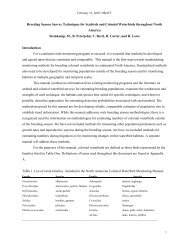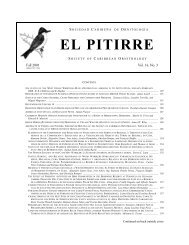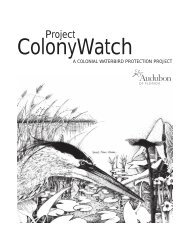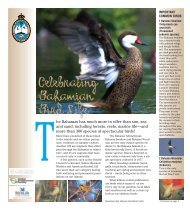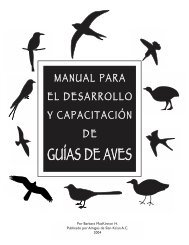body draft - Society for the Conservation and Study of Caribbean Birds
body draft - Society for the Conservation and Study of Caribbean Birds
body draft - Society for the Conservation and Study of Caribbean Birds
- No tags were found...
You also want an ePaper? Increase the reach of your titles
YUMPU automatically turns print PDFs into web optimized ePapers that Google loves.
A BIRDING TRIP TO THE DOMINICAN REPUBLIC AND PUERTO RICOSTEFAN LITHNERVinkelgatan 26 B, 374 38 Karlshamn, Sweden; e-mail: s.lithner@delta.telenordia.seAbstract. – During a birding trip to <strong>the</strong> Dominican Republic <strong>and</strong> Puerto Rico, 20 September to 4 October1999, 25 <strong>of</strong> <strong>the</strong> 26 endemics <strong>of</strong> Hispaniola <strong>and</strong> all <strong>of</strong> <strong>the</strong> 16 endemic species <strong>of</strong> Puerto Rico were observed. In all,we identified 134 species <strong>of</strong> birds on Hispaniola <strong>and</strong> 99 species in Puerto Rico.Resumen. – UN VIAJE PARA OBSERVAR AVES EN LA REPÚBLICA DOMINICANA Y PUERTO RICO. Durante unviaje a la República Dominicana y Puerto Rico para observar aves, efectuado entre el 20 de septiembre y el 4 deoctubre de 1999, 25 de los 26 endemismos de La Española y todos los 16 endemismos de Puerto Rico fueron observados.En total, identificamos 134 especies en La Española y 99 en Puerto Rico.Key words: bird list, Dominican Republic, Hispaniola, Puerto RicoFROM 20 SEPTEMBER through 4 October 1999,three travelling companions, Karl-Erik GustafssonTvååker, Stefan Andersson Forsheda, <strong>and</strong> TommyThorén Varnamo, <strong>and</strong> I traveled extensively throughsouthwestern Dominican Republic <strong>and</strong> Puerto Ricoin an attempt to observe all endemic species <strong>of</strong> birds.We were equipped with binoculars, spotting scopes,<strong>and</strong> a mini-disc (MD) tape player. Gustafsson hadcompiled recordings <strong>of</strong> all species we consideredcould be difficult to observe, as well as <strong>the</strong> birds weexpected to hear a great deal more than see.Our ef<strong>for</strong>ts in <strong>the</strong> Dominican Republic were centeredaround Barahona, including <strong>the</strong> BaorucoMountains, <strong>the</strong> coast south <strong>of</strong> this range, <strong>and</strong> <strong>the</strong> vicinity<strong>of</strong> Lago Enriquillo. During our six days in <strong>the</strong>Dominican Republic, we traveled <strong>the</strong> road past Duvergé,Puerto Escondido, El Aguacate, <strong>and</strong> <strong>the</strong> siteknown as “The Bulldozer.” We birded at someplaces along <strong>the</strong> road to Pedernales <strong>and</strong> <strong>the</strong> secondaryroad from Pedernales, over <strong>the</strong> Baoruco Mountains,to El Aguacate. We also spent some time atsites along <strong>the</strong> western side <strong>of</strong> Lago de Enriquillo.In Puerto Rico we visited El Yunque, HumacaoRefuge, Guánica State Forest, Playa la Parguera,Maricao Camp area, Hacienda Juanita, Barceloneta,Río Gr<strong>and</strong>e, <strong>and</strong> Luquillo. The <strong>for</strong>ested areas on bothisl<strong>and</strong>s were visited at different hours <strong>of</strong> <strong>the</strong> day, i.e.be<strong>for</strong>e <strong>and</strong> during dawn, after daybreak <strong>and</strong> mid-day.The lake areas were visited during daylight, at dusk,<strong>and</strong> after dusk.All observations <strong>of</strong> birds, as well as time <strong>of</strong> day<strong>and</strong> how to get to <strong>the</strong> sites <strong>of</strong> <strong>the</strong> rarer birds werecarefully described. For a more detailed report seeLithner (1999), <strong>and</strong> <strong>for</strong> a full report on all birds observed,see Gustafsson (1999), where all species arelisted in English <strong>and</strong> in Latin. Here, I present highlights<strong>of</strong> our searches, with a table <strong>of</strong> all species seenin both counties (Table 1). We were ably assisted bySr. Julio Felíz in <strong>the</strong> Dominican Republic, <strong>and</strong> by Sr.Jafet Valdéz in Puerto Rico. I have included several<strong>of</strong> <strong>the</strong>ir comments here since <strong>the</strong>y contributed todeepen our knowledge <strong>of</strong> <strong>the</strong> birds <strong>and</strong> underst<strong>and</strong>ing<strong>of</strong> <strong>the</strong>ir problems. Here I provide a narrative <strong>of</strong>our searches, listing endemics found <strong>and</strong> locations,as well as o<strong>the</strong>r interesting observations.RESULTSHispaniola21 September. – Road to Cabral, 9.7 km (6 mi) east<strong>of</strong> Barahona: Broad-billed Tody (Todus subulatus),Greater Antillean Bullfinch (Loxigilla violacea),Stolid Flycatcher (Myiarcus stolidus), among o<strong>the</strong>rspecies observed.“Bulldozer area” beyond <strong>the</strong> military checkpoint atEl Aguacate, Sierra de Baruco: Hispaniolan StripeheadedTanager (Spindalis dominicensis), NarrowbilledTody (Todus angustirostris), Black-headedPalm-Tanager (Phaenicophilus palmarum), HispaniolanParrot (Amazona ventralis), AntilleanMango (Anthracothorax dominicus), HispaniolanEmerald (Chlorostilbon swainsonii), <strong>and</strong> numerousHispaniolan Trogon (Priotelus roseigaster). Some200 m above <strong>the</strong> military checkpoint, we located asmall flock <strong>of</strong> White-winged Crossbills (Loxia leucoptera),Antillean Siskins (Carduelis dominicensis),a flock <strong>of</strong> Hispaniolan Parakeets (Aratinga chloroptera),<strong>and</strong> a White-winged Warbler (Xenoligea montana).A Hispaniolan Lizard-Cuckoo (Sauro<strong>the</strong>alongirostris) was recorded near El Aguacate.El Pitirre 14(1) Page 11




